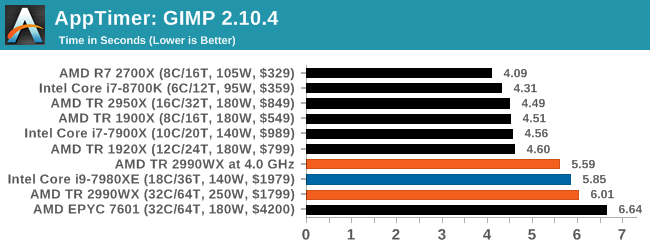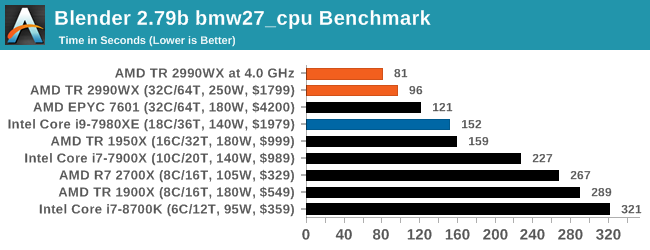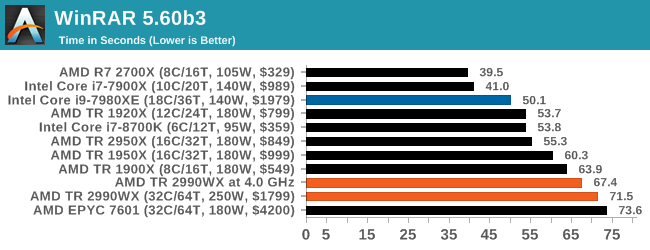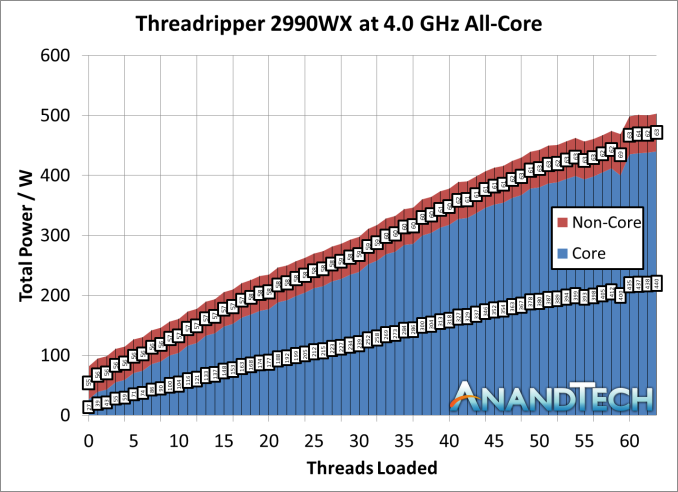The AMD Threadripper 2990WX 32-Core and 2950X 16-Core Review
by Dr. Ian Cutress on August 13, 2018 9:00 AM ESTOverclocking: 4.0 GHz for 500W
Who said that a 250W processor should not be overclocked? AMD prides itself as being a processor manufacturer that offers every consumer processor as a multiplier unlocked part, as well as using a soldered thermal interface material to assist with thermal dissipation performance. This 2990WX has an X in the same, so let the overclocking begin!
Actually, confession time. We did not have much time to do overclocking by any stretch. This processor has a 3.0 GHz base frequency and a 4.2 GHz turbo frequency, and in an air-conditioned room using the 500W Enermax Liqtech cooler, when running all cores under POV-Ray, we observed each core running around 3150 MHz, which is barely above the turbo frequency. The first thing I did was set the all-core turbo to 4.2 GHz, the same as the single core turbo frequency. That was a bust.
However, the next stage of my overclocking escapades surprised me. I set the CPU to a 40x multiplier in the BIOS, for 4.0 GHz on all the cores, all the time. I did not adjust the voltage, it was kept at auto, and I was leaving the ASUS motherboard to figure it out. Lo and behold, it performed flawlessly through our testing suite at 4.0 GHz. I was shocked.
All I did for this overclock was turn a setting from ‘auto’ to ‘40’, and it breezed through almost every test I threw at it. I say almost every test – our Prime95 power testing failed. But our POV-Ray power testing, which draws more power, worked. Every benchmark in the suite worked. Thermals were high (in the 70s), but the cooler could take it, and with good reason too.
At full load in our POV-Ray test, the processor was listed as consuming 500W. The cooler is rated for 500W. At one point we saw 511W. This was split between 440W for the cores (or 13.8W per core) and 63W for the non-core (IF, IO, IMC) which equates to only 12.5% of the full power consumption. It answers the question from our Infinity Fabric power page - if you want the interconnect to be less of the overall power draw, overclock!
We also tried 4.1 GHz, and that seemed to work as well, although we did not get a full benchmark run out of it before having to pack the system up. As stated above, 4.2 GHz was a no-go, even when increasing the voltage. With tweaking (and the right cooling), it could be possible. For anyone wanting to push here, chilled water might be the way to go.
Performance at 4.0 GHz
So if the all-core frequency was 3125 MHz, an overclock to 4000 MHz all-core should give a 28% performance increase, right? Here are some of the key tests from our suite.






Overclocking the 2990WX is a mixed bag, because of how it does really well in some tests, and how it still sits behind the 2950X in others due to the bi-modal nature of the cores. In the tests were it already wins, it pushes out a lot more: Blender is up 19% in throughput, POV-Ray is up 19%, 3DPM is up 19%. The other tests, is catches back up to the 2950X (Photoscan), or still lags behind (app loading, WinRAR).
Overclocking is not the cure-all for the performance issues on the 2990WX, but it certainly does help.











171 Comments
View All Comments
edzieba - Monday, August 13, 2018 - link
Not really. In chasing Moar Cores you only excel in embarrassingly parallel workloads. And embarrassingly parallel workloads are in GPGPU's house. And GPU lives in GPGPU's house.boeush - Monday, August 13, 2018 - link
Try to run multiple VMs/Containers and/or multiple desktop sessions on a GPGPU: you might find out that GPGPU's house isn't all it's cracked up to be...SonicKrunch - Monday, August 13, 2018 - link
Look at that power consumption. I'm not suggesting AMD didn't create a really great CPU here, but they really need to work on their efficiency. It's always been their problem, and it's not seemingly going away. The market for these near 2k chips is also not huge in comparison to normal desktop space. Intel has plenty of time to answer here with their known efficiency.The_Assimilator - Monday, August 13, 2018 - link
Yeah... look at the number of cores, numpty.somejerkwad - Monday, August 13, 2018 - link
The same efficiency that has consumer-grade products operating on more electricity in per-core and per-clock comparisons? Overclocking power gets really silly on Intel's high end offerings too, if you care to look at the numbers people are getting with an i9 that has fewer cores.eddman - Monday, August 13, 2018 - link
Interesting, can you post a link, please? I've read a few reviews here and there and when comparing 2600x to 8700k (which is more or less fair), it seems in most cases 8700k consumes less energy, even though it has higher boost clocks.CrazyElf - Monday, August 13, 2018 - link
The 8700k is not the problem. It is Skylake X.https://www.tomshardware.com/reviews/-intel-skylak...
Power consumption when you OC X299 scales up quickly. Threadripper is not an 8700k competitor. It is an X299 competitor. The 32 core AMD is clearly priced to compete against the 7980X, unless Intel cuts the price.
eddman - Tuesday, August 14, 2018 - link
I should've made it clear. I was replying to the "more electricity in per-core and per-clock" part. Also, he wrote consumer-grade, which is not HEDT. I do know that TR competes with SKL-X.Comparing OCing power consumption is rather pointless when one chip is able to clock much higher.
Even when comparing 2950 to 7980, there are a lot of instances where 7980 consumes about the same power or even less. I don't see how ryzen is more efficient.
alpha754293 - Monday, August 13, 2018 - link
@ibnmadhi"It's over, Intel is finished."
Hardly.
For example, the Threadripper 2990WX (32C, 3.0 GHz) gets the highest score in POV-Ray 3.7.1 benchmark, but when you compute the efficiency, it's actually the worst for it.
It consumes more power and only gets about 114 points per (base clock * # of cores - which is a way to roughly estimate the CPU's total processing capability).
By comparison, the Intel Core i9-7980XE (18C, 2.6 GHz) is actually the MOST EFFICIENT at 168 points per (base clock * # of cores). It consumes less power than the Threadripper processors, but it does also cost more.
If I can get a system that can do as much or more for less, both in terms of capital cost and running cost (i.e. total cost of ownership), then why would I want to go AMD?
I use to run all AMD when it was a better value proposition and when Intel's power profile was much worse than AMD's. Now, it has completely flipped around.
Keep also in mind, that they kept the Epyc 7601 processor in here for comparison, a processor that costs $4200 each.
At that price, I know that I can get an Intel Xeon processor, with about the same core count and base clock speed for about the same price, but I also know that it will outperform the Epyc 7601 as well when you look at the data.
As of August, 2018, Intel has a commanding 79.4% market share compared to AMD's 20.6%. That's FARRR from Intel being over.
ender8282 - Monday, August 13, 2018 - link
base clock * number of cores seems like a poor stand in for performance per watt. If we assume that IPC and other factors like mem/cache latency are the same then sure base clock * num cores effectively gives us performance unit of power but we know those are not constant.